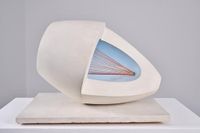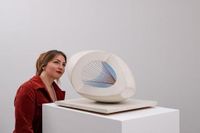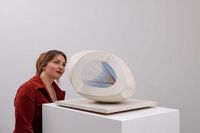In an extraordinary show of public and institutional support, Barbara Hepworth’s rare 1943 sculpture, Sculpture with Colour (Oval Form) Pale Blue and Red, will soon take its place in the UK’s national collection—on permanent display for the very first time. The journey to secure this iconic work for the nation was marked by a groundswell of generosity, a race against time, and a deep appreciation for one of Britain’s most influential artists.
According to The Independent, the campaign to acquire the sculpture was sparked after it was sold at Christie’s London in March 2024 for £3.55 million to a private collector. Recognizing the artwork’s significance, the UK’s Department for Culture, Media, and Sport swiftly issued a rare temporary export bar in November 2024. This move, as reported by Artnet News, gave UK institutions the chance to match the purchase price, including taxes, to keep the piece in the country. The Reviewing Committee on the Export of Works of Art and Objects of Cultural Interest deemed the sculpture to be of “outstanding significance,” setting the stage for a high-profile rescue mission.
The Hepworth Wakefield, an acclaimed art museum in West Yorkshire and the artist’s hometown, took up the challenge in June 2025, launching a public appeal with national charity Art Fund. The goal: raise £3.8 million before the August 27 deadline. The response was overwhelming. Over 2,800 public donations poured in, joined by major grants and gifts from institutions and foundations. The National Lottery Heritage Fund contributed a remarkable £1.89 million, while Art Fund pledged an exceptional £750,000. Additional support came from the Deborah Loeb Brice Foundation, The Forster Foundation, The Garcia Family Foundation, Garfield Weston Foundation, The Headley Trust, the Hepworth family, The Henry Moore Foundation, The Julia Rausing Trust, and a host of other donors.
By August 19, 2025, the campaign had not only met but surpassed its ambitious target, as confirmed by BBC and The Independent. Olivia Colling, Interim Director and CEO of The Hepworth Wakefield, expressed heartfelt gratitude: “We are enormously grateful for the generosity people have shown in helping us to bring this extremely rare and important work to Wakefield, the UK’s capital of sculpture.” Colling added that Hepworth herself, who “often talked about her need to be part of a community and to develop it proactively,” would have been “delighted that so many people have come together to enable her work to be part of a public art collection which can be experienced and enjoyed by so many.”
The sculpture’s journey to public display is as compelling as its artistic legacy. Created during the height of World War II, Sculpture with Colour (Oval Form) Pale Blue and Red is one of only a small number of wooden carvings Hepworth produced during the 1940s—and the first major example to incorporate strings. According to Artnet News, Hepworth crafted the piece after relocating from London to St. Ives, Cornwall, seeking safety for her family, including her four-year-old triplets. Working under the constraints of wartime rationing, she received a special permit to obtain wood, then juggled childcare, domestic chores, and creative labor in short, precious bursts. As Eleanor Clayton, head of collection and exhibitions at The Hepworth Wakefield, told The Guardian: “She was juggling childcare and domestic chores. She wrote in a letter to a friend and critic how she had to work for 30 minutes, and then she had to cook for the children, and then she’d go back to the studio and carve for another 20 minutes. Then she’d have to go and do some washing. It’s sort of astonishing that it was made within these circumstances and with the threat of war in the background.”
For decades, the sculpture remained in private hands and was rarely seen by the public. Its acquisition fills a significant gap in The Hepworth Wakefield’s collection, which, until now, lacked any works by Hepworth from her formative 1940s period. The gallery plans a dedicated display to examine the work’s history and meaning. As BBC reported, the piece is “interpreted as a demonstration of her adaptability and resilience,” inspired by the Cornish landscape and shaped by the extraordinary circumstances of its creation.
The campaign’s momentum was bolstered by the support of leading contemporary artists, including Antony Gormley, Anish Kapoor, Rachel Whiteread, and Richard Deacon. Deacon, who first encountered the sculpture as a teenager at a Tate retrospective in 1968, described it as “a testament to the undaunted spirit of a great artist and to her steadfast belief in an anticipated future.” He told The Independent, “It is a fantastic piece achieved under such difficult conditions and one that has such optimism and hope within it.” Deacon also praised the “clarity” and “elegance” of Hepworth’s carving, noting the “healing aspect to the way that the strings work in relationship to the void of the space.”
Hepworth’s international influence is undeniable. Her pioneering use of negative space and abstraction helped redefine the language of modern sculpture. As Kapoor observed, “This sculpture comes from a period of work by Hepworth in which she explores form and emptiness and looks forward to radical modernity.” The oval form, a recurring motif in Hepworth’s oeuvre, was described by the artist herself as “sufficient field for exploration to last a lifetime,” according to Christie’s.
The significance of the acquisition resonates far beyond the art world. For Wakefield, the victory is deeply personal. The Hepworth Wakefield, a striking concrete building and the largest purpose-built gallery outside London, offers free exhibitions for local residents and stands as a cultural beacon in the north of England. Eleanor Clayton, the gallery’s curator, emphasized to The Independent, “We recognised her as one of the most important artists of the 20th century. It’s amazing that she came from this city in the north of England and achieved such a world-renowned reputation.”
The successful campaign to save Hepworth’s sculpture is part of a wider trend in the UK to retain treasured artworks for public enjoyment. In recent years, similar efforts have secured masterpieces by Fra Angelico and Joshua Reynolds, underscoring the nation’s commitment to preserving its cultural heritage.
For now, anticipation is high as The Hepworth Wakefield prepares to unveil Sculpture with Colour (Oval Form) Pale Blue and Red to the public. A rare masterpiece, born of adversity and sustained by collective effort, is finally coming home.


